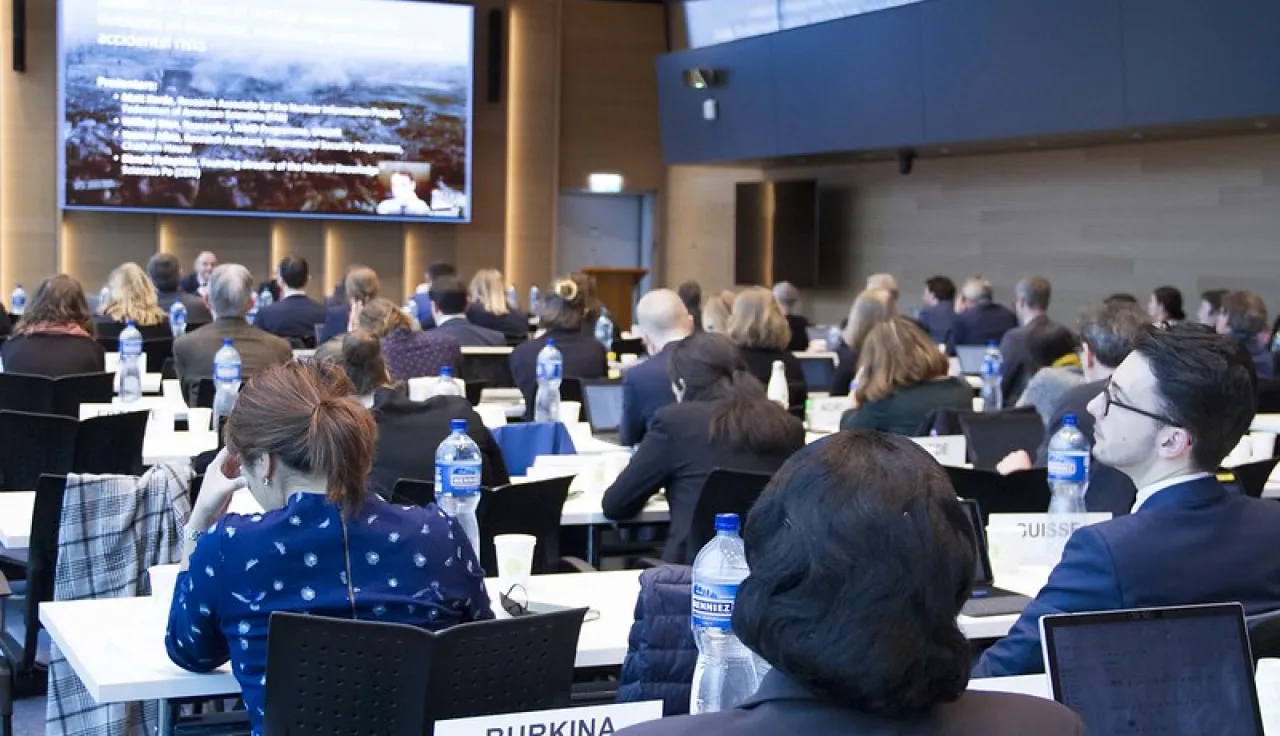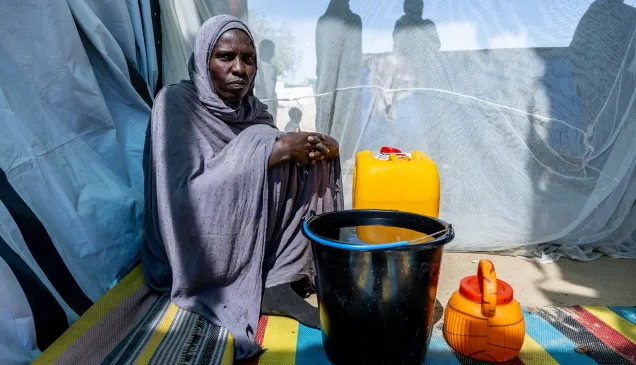I. Introduction
1. On 2 March 2020, the International Committee of the Red Cross (ICRC) and the International Federation of Red Cross and Red Crescent Societies (IFRC) convened a full-day expert meeting on the humanitarian impacts and risks of the use of nuclear weapons. Based on existing and emerging expert research, the meeting aimed to take stock of the humanitarian and environmental consequences of the use and testing of nuclear weapons, as well as the drivers of nuclear risk.
2. In addition to scientific experts from inter alia Sciences Po, Columbia University, Rutgers University, the Federation of American Scientists, Chatham House, the Gender and Radiation Impact Project and the United Nations Institute for Disarmament Research, representatives from approximately 45 states and a range of UN agencies and civil society organizations took part in the meeting. This paper provides a summary of the discussions and is published by the ICRC and the IFRC. It does not necessarily represent the views of the participants.
II. The catastrophic humanitarian consequences of nuclear weapons
3. The horrific devastation and suffering witnessed in Hiroshima and Nagasaki in 1945 by Japanese Red Cross and ICRC medical staff, as they attempted to help tens of thousands of dying and wounded people, have left an enduring mark on the entire International Red Cross and Red Crescent Movement and have driven its advocacy of the prohibition and elimination of nuclear weapons over the last 75 years.[1] A few weeks after the atomic bombings of Hiroshima and Nagasaki in 1945, the ICRC and other organizations began documenting the effects of the nuclear explosions on human health, the environment and medical infrastructure.[2]
4. Evidence of the immediate and longer-term impacts of the use and testing of nuclear weapons has been the subject of scientific investigation ever since. In a major 1987 report, the World Health Organization (WHO) summarized existing research into the impacts on health and health services of nuclear detonations. The report noted inter alia that the blast wave, thermal wave, radiation and radioactive fallout generated by nuclear explosions have devastating short- and long-term effects on the human body, and that existing health services are not equipped to alleviate these effects in any significant way.[3] Since then, the body of evidence of the immediate and longer-term humanitarian impacts of nuclear weapons use and testing, and of the preparedness and capacity of national and international organizations and health systems to provide assistance to the victims of such events, has been growing steadily.[4]
5. In 2013 and 2014, three international conferences were organized by the governments of Norway, Mexico and Austria to comprehensively assess existing knowledge of the humanitarian consequences of nuclear weapons.[5] The evidence presented at the three conferences demonstrated inter alia the following:
- A nuclear weapon detonation in or near a populated area would – as a result of the blast wave, intense heat, and radiation and radioactive fallout – cause massive death and destruction, trigger large-scale displacement[6] and cause long-term harm to human health and well-being, as well as long-term damage to the environment, infrastructure, socioeconomic development and social order.[7]
- Modern environmental modelling techniques demonstrates that even a “small-scale” use of some 100 nuclear weapons against urban targets would, in addition to spreading radiation around the world, lead to a cooling of the atmosphere, shorter growing seasons, food shortages and a global famine.[8]
- The effects of a nuclear weapon detonation, notably the radioactive fallout carried downwind, cannot be contained within national borders.[9]
- The scale of destruction and contamination after a nuclear detonation in or near a populated area could cause profound social and political disruption as it would take several decades to reconstruct infrastructure and regenerate economic activities, trade, communications, health-care facilities and schools.[10]
- No state or international body could address, in an appropriate manner, the immediate humanitarian emergency nor the long-term consequences of a nuclear weapon detonation in a populated area, nor provide appropriate assistance to those affected. Owing to the massive suffering and destruction caused by a nuclear detonation, it would probably not be possible to establish such capacities, even if attempted, although coordinated preparedness may, nevertheless, be useful in mitigating the effects of an event involving the explosion of an improvised nuclear device.[11]
- Notably, owing to the long-lasting effects of exposure to ionizing radiation, the use or testing of nuclear weapons has, in several parts of the world, left a legacy of serious health and environmental consequences[12] that disproportionally affect women and children.[13]
6. The immediate and longer-term humanitarian and environmental consequences of nuclear weapons use and testing continue to be subject to scientific scrutiny, with emerging evidence and analysis inter alia of the sex- and age-differentiated impacts of ionizing radiation on human health,[14] the long-term impacts of nuclear weapons testing on the environment,[15] including on mortality and infant mortality rates,[16] the consequences of a nuclear war on the global climate,[17] food security,[18] ocean acidification,[19] as well as evidence and analysis of regional preparedness and response measures to nuclear testing.[20] While there are some aspects of these impacts that are not fully understood and require further study (see paragraph 17), these scientific studies reveal new and compelling evidence of long-term harm to human health and the environment from the use and testing of nuclear weapons.
7. There is a particular need for continued and scaled-up efforts to research and understand the humanitarian and environmental consequences of nuclear weapons testing. Communities in former nuclear testing areas – including the Marshall Islands,[21] Kazakhstan,[22] Algeria[23] and the United States[24] – continue to be affected today by the impacts of ionizing radiation released from nuclear tests that occurred decades ago. Many communities report that they do not have sufficient information about their own history of exposure, the current risks of living in a radioactively contaminated area and the intergenerational risks associated with radiation exposure.[25] A lack of transparency and a failure to take the perspectives, lifestyles and needs of communities into account are barriers that need to be overcome in future research efforts.
8. Moreover, while it has been established that women and children are disproportionally affected by ionizing radiation, little is known about the effects of ionizing radiation on reproductive health. Possible questions for further research in this area include: Why is biological sex a factor in radiation harm? Why are the biological sex differences in radiation harm greatest in young children? Is the percentage of reproductive tissue and how it reacts to radiation a contributing factor?[26]
III. The risk of the use of nuclear weapons
9. Evidence of the foreseeable impacts of a nuclear detonation is an integral part of a nuclear weapons risk assessment. Although nuclear weapons have not been used in armed conflict since 1945, there has been a disturbingly high number of close calls in which nuclear weapons were nearly used inadvertently as a result of miscalculation or error.[27] During the three conferences on the humanitarian impacts of nuclear weapons in 2013 and 2014, it was demonstrated that the risks of a nuclear weapon detonation, whether by accident, miscalculation or design, stem notably from:
- the vulnerability of nuclear weapon command-and-control networks to human error and cyberattacks
- the maintaining of nuclear arsenals on high levels of alert, with thousands of weapons ready to be launched within minutes
- the dangers of access to nuclear weapons and related materials by non-state actors.
10. The conferences furthermore observed that international and regional tensions between nuclear-armed states, coupled with existing military doctrines and security policies that give a prominent role to nuclear weapons, increase the risk of nuclear weapons being used, and concluded that, given the catastrophic consequences of a nuclear weapon detonation, the risk of nuclear weapons being used is unacceptable, even if the probability of such an event were considered low.[28]
11. Since the three conferences on the humanitarian impacts of nuclear weapons, the risk that nuclear weapons may be used has increased. While there are different ways to conceptualize nuclear risks and the sources of these risks, the increased probability of nuclear weapons being used is driven by the following interconnected developments:
- After decades of significant cuts in the global nuclear arsenal, the trend towards nuclear reductions is now being replaced by a process of modernization and development of new nuclear weapons with novel, “more usable” capabilities.[29]
- Nuclear weapons are acquiring a more important role in the military doctrines and security strategies of nuclear-armed states, marked, most notably, by a return to considerations of “nuclear warfighting” and an expansion of the circumstances in which the use of nuclear weapons may be considered.[30]
- Broader technological developments, new missile technologies, increased activities and reliance on infrastructure in space, as well as the integration of digital technologies in nuclear command, control and communications, increases complexity in decision-making processes, thereby heightening the risk of misinterpretations and misunderstandings that could trigger the use of nuclear weapons.[31]
- The erosion of the nuclear arms control legal framework – indicated, for example, by the abrogation of the Intermediate-range Nuclear Forces (INF) Treaty – reduces transparency and predictability in policy and decision-making processes, making it more difficult to read the adversary’s intent.[32]
- Broader geopolitical developments, with increasingly tense relationships and the possibility of conflict across several contexts between nuclear-armed and nuclear-allied states, increases the risk of escalation.[33]
12. It is possible to conceptualize the increasing risk of nuclear weapons being used according to the following four risk-of-use scenarios:
a) doctrinal use of nuclear weapons, i.e. the use of nuclear weapons as outlined and envisaged in declared policies, doctrines, strategies and concepts
b) escalatory use, i.e. the use of nuclear weapons in an ongoing situation of tension or conflict
c) unauthorized use, i.e. the non-sanctioned use of nuclear weapons by a non-state actor
d) accidental use, i.e. the use of nuclear weapons through error, including technical malfunction and human error.[34]
13. When assessing the risks arising from technological developments, it is important to consider these technologies both individually and in combination. New technologies may interrelate and depend on each other, thus affecting decision-making systems in unpredictable ways. For example, increased reliance on digital technologies in decision-making processes may create new sources of error that may be difficult to detect, potentially leading to a misplaced overconfidence in the ability of these technologies to deliver accurate information. The introduction and use of new technologies may also lead a state to misinterpret or misunderstand the behaviour of another state, thereby increasing the likelihood of unnecessary escalation.[35]
14. It is important to note that offering an objective and meaningful quantification of these risks may not be possible and engaging in such quantification may create a sense of overconfidence. Objective probability estimates are based on experience and exclude new and unprecedented paths to nuclear catastrophe. Using the language of risk may therefore create a false sense of controllability and manageability by creating an illusion that all the possible paths to disaster have been anticipated and accounted for. The concepts of “luck” and “vulnerability” may better capture our inability to control and manage the possible use of nuclear weapons and therefore provide a more accurate understanding of the dangers posed by these weapons.[36]
IV. Conclusions
15. Research into the various immediate and long-term impacts of nuclear weapons use and testing is important in itself because it informs us of the unique characteristics of these weapons. Such research also provides a crucial basis for humanitarian preparedness and response, and is important in upholding the rights of the individuals and communities affected. The evidence of the humanitarian impacts of nuclear weapons is essential to assess the legality of their use under international humanitarian law (IHL) and it gives a fact-based entry point for discussions about nuclear disarmament and nuclear non-proliferation, more broadly.
16. The evidence of harm caused by the use and testing of nuclear weapons takes on a renewed importance in a world in which the risk of nuclear weapons being used is increasing. From a humanitarian perspective, any measure to reduce the risk of nuclear weapons being used is to be welcomed. Indeed, preventing the use of nuclear weapons is of the utmost urgency. At the same time, nuclear risk reduction cannot become a substitute for the implementation of states’ legally binding obligations to achieve nuclear disarmament, notably those under the Treaty on the Non-Proliferation of Nuclear Weapons.[37] The only way to guarantee that nuclear weapons are never used again is by prohibiting and eliminating them.
17. Although much is already known about the humanitarian and environmental impacts of nuclear weapons, there is a need for more research in certain areas. In particular, we need to understand more about the long-term humanitarian and environmental effects of nuclear weapons testing, as well as the sex- and age-differentiated and, potentially, intergenerational consequences of ionizing radiation.
***
[1] Linh Schroeder, “The ICRC and the Red Cross and Red Crescent Movement: Working Towards a Nuclear-Free World since 1945”, 2017: https://doi.org/10.1080/25751654.2018.1450623, all web addresses accessed 8 July 2020; Jakob Kellenberger, “Bringing the era of nuclear weapons to an end”,statement by the President of the ICRC to the Geneva Diplomatic Corps, Geneva, 20 April 2010: https://www.icrc.org/en/doc/resources/documents/statement/nuclear-weapons-statement-200410.htm.
[2] ICRC, “ICRC report on the effects of the atomic bomb at Hiroshima”, 2016: https://international-review.icrc.org/articles/icrc-report-effects-atomic-bomb-hiroshima.
[3] WHO, Effects of Nuclear War on Health and Health Services, 1987: https://apps.who.int/iris/handle/10665/39199.
[4] John Borrie and Tim Caughley, An Illusion of Safety: Challenges of Nuclear Weapon Detonations for United Nations Humanitarian Coordination and Response, UNIDIR, 2014, pp. 8–15 for a contextual overview of research into the humanitarian consequences and capacities to respond to nuclear detonations: https://unidir.org/publication/illusion-safety-challenges-nuclear-weapon-detonations-united-nations-humanitarian.
[5] Alexander Kmentt, “The Humanitarian Consequences and Risks of Nuclear Weapons: Taking stock of the main findings and substantive conclusions”, presentation to the ICRC and IFRC expert meeting in Geneva on 2 March 2020 with an overview of the evidence presented at the three conferences; ILPI, “Evidence of Catastrophe: A summary of the facts presented at the three conferences on the humanitarian impact of nuclear weapons”, ILPI, 2015.
[6] Simon Bagshaw, Population Displacement: Displacement in the Aftermath of Nuclear Weapon Detonation Events, ILPI-UNIDIR, 2014: https://unidir.org/publication/population-displacement-displacement-aftermath-nuclear-weapon-detonation-events.
[7] Article 36, “Economic impact of a nuclear weapon detonation”, 2015: http://www.article36.org/wp-content/uploads/2015/08/Economic-impact.pdf.
[8] Alan Robock et al., “Global Famine after a Regional Nuclear War: Overview of Recent Research”, 2014, presentation to the Vienna Conference on the Humanitarian Impact of Nuclear Weapons: https://www.bmeia.gv.at/fileadmin/user_upload/Zentrale/Aussenpolitik/Abruestung/HINW14/Presentations/HINW14_S1_Presentation_Michael_Mills.pdf.
[9] Matthew McKinzie et al., “Calculating the Effects of a Nuclear Explosion at a European Military Base”, 2014, presentation to the Vienna Conference on the Humanitarian Impact of Nuclear Weapons: https://www.bmeia.gv.at/fileadmin/user_upload/Zentrale/Aussenpolitik/Abruestung/HINW14/Presentations/HINW14_S1_Presentation_NRDC_ZAMG.pdf.
[10] Neil Buhne, “Social and economic impacts: Structural restoration of lives and livelihoods in and around affected areas”, 2013, presentation to the Conference on the Humanitarian Impact of Nuclear Weapons, Oslo: https://www.regjeringen.no/globalassets/upload/ud/vedlegg/hum/hum_buhne.pdf.
[11] Dominique Loye and Robin Coupland, “Who will assist the victims of use of nuclear, radiological, biological or chemical weapons – and how?”, 2007: https://international-review.icrc.org/articles/who-will-assist-victims-use-nuclear-radiological-biological-or-chemical-weapons-and-how; ICRC, “Humanitarian assistance in response to the use of nuclear weapons”, 2013: https://www.icrc.org/en/doc/assets/files/2013/4132-3-nuclear-weapons-humanitarian-assistance-2013.pdf; John Borrie and Tim Caughley, An Illusion of Safety: Challenges of Nuclear Weapon Detonations for United Nations Humanitarian Coordination and Response, UNIDIR, 2014: https://www.unidir.org/files/publications/pdfs/an-illusion-of-safety-en-611.pdf.
[12] John Borrie, A Harmful Legacy: The Lingering Humanitarian Impacts of Nuclear Weapons Testing, ILPI-UNIDIR, 2014: https://unidir.org/publication/harmful-legacy-lingering-humanitarian-impacts-nuclear-weapons-testing; Roman Vakulchuk and Kristian Gjerde, Semipalatinks nuclear testing: the humanitarian consequences, Norwegian Institute of International Affairs, 2014: http://large.stanford.edu/courses/2014/ph241/powell2/docs/vakulchuk.pdf.
[13] Anne Guro Dimmen, Gendered Impacts: The Humanitarian Impacts of Nuclear Weapons from a Gender Perspective, ILPI-UNIDIR, 2014: https://unidir.org/publication/gendered-impacts-humanitarian-impacts-nuclear-weapons-gender-perspective.
[14] Mary Olson, “Disproportionate impact of radiation and radiation regulation”, Interdisciplinary Science Reviews, 2019: https://www.tandfonline.com/doi/full/10.1080/03080188.2019.1603864, presented to the ICRC and IFRC expert meeting in Geneva on 2 March 2020. (In November 2022, Olson corrected an error in one of her visualizations of the degree of difference in cancer outcomes from the exposure of young girls and adult males, respectively: A Correction — Gender + Radiation Impact Project)
[15] Maveric K.I.L. Abella et al., “Background gamma radiation and soil activity measurements in the northern Marshall Islands”,
Proceedings of the National Academy of Sciences of the United States of America (PNAS), 2019: https://www.pnas.org/content/pnas/116/31/15425.full.pdf; Emlyn W. Hughes et al., “Radiation maps of ocean sediment from the Castle Bravo crater”, PNAS, 2019: https://www.pnas.org/content/pnas/116/31/15420.full.pdf; Carlisle E. W. Topping et al., “In situ measurement of cesium-137 contamination in fruits from the northern Marshall Islands”, PNAS, 2019: https://www.pnas.org/content/pnas/116/31/15414.full.pdf; R. Giles Harrison et al., “Precipitation Modification by Ionization”, Physical Review Letters, 2020: https://journals.aps.org/prl/abstract/10.1103/PhysRevLett.124.198701.
[16] Kathleen M. Tucker and Robert Alvarez, “Trinity: “The most significant hazard of the entire Manhattan Project””, Bulletin of the Atomic Scientists, 2019: https://thebulletin.org/2019/07/trinity-the-most-significant-hazard-of-the-entire-manhattan-project/; Keith Meyers, “Some Unintended Fallout from Defense Policy: Measuring the Effect of Atmospheric Nuclear Testing on American Mortality Patterns”, 2019: https://static1.squarespace.com/static/59262540b3db2b0d0d6d7d2b/t/5c81809a419202f922f0cfa4/1551990940274/Fallo%20utMortDraft_3-5-2019.pdf.
[17] Alan Robock et al., “How an India-Pakistan nuclear war could start–and have global consequences”, Bulletin of the Atomic Scientists, 2019: http://climate.envsci.rutgers.edu/pdf/IndiaPakistanBullAtomSci.pdf.
[18] Jonas Jägermeyr et al., “A regional nuclear conflict would compromise global food security”, PNAS, 2020: http://climate.envsci.rutgers.edu/pdf/JagermeyrPNAS.pdf.
[19] Nicole S. Lovenduski et al., “The Potential Impact of Nuclear Conflict on Ocean Acidification”, Geophysical Research Letters, 2020: https://agupubs.onlinelibrary.wiley.com/doi/10.1029/2019GL086246.
[20] Beyza Unal, Patricia Lewis and Sasan Aghlani, “The Humanitarian Impacts of Nuclear Testing: Regional Responses and Mitigation Measures”, Chatham House, 2017: https://www.chathamhouse.org/publication/humanitarian-impacts-nuclear-testing-regional-responses-and-mitigation-measures.
[21] Susanne Rust, “How the U.S. betrayed the Marshall Islands, kindling the next nuclear disaster”, Los Angeles Times, 2019: https://www.latimes.com/projects/marshall-islands-nuclear-testing-sea-level-rise/.
[22] Wudan Yan, “The nuclear sins of the Soviet Union live on in Kazakhstan”, Nature, 2019: https://www.nature.com/articles/d41586-019-01034-8.
[23] Johnny Magaleno, “Algerians suffering from French atomic legacy, 55 years after nuke tests”, Al Jazeera, 2015: http://america.aljazeera.com/articles/2015/3/1/algerians-suffering-from-french-atomic-legacy-55-years-after-nuclear-tests.html.
[24] Lilly Adams, “The human cost of nuclear weapons is not only a “feminine” concern”, Bulletin of the Atomic Scientists, 2019: https://thebulletin.org/2019/11/the-human-cost-of-nuclear-weapons-is-not-only-a-feminine-concern.
[25] Masaki Koyanagi, presentation to the Second International Conference on the Humanitarian Impact of Nuclear Weapons, 2014: https://www.reachingcriticalwill.org/images/documents/Disarmament-fora/nayarit-2014/statements/Hibakusha-Koyanagi.pdf, giving the perspective of a third-generation hibakusha. The Radiation Effects Research Foundation (RERF) is currently carrying out a research programme on the children of atomic-bomb survivors.
[26] Mary Olson, presentation to the ICRC and IFRC expert meeting in Geneva on 2 March 2020.
[27] Patricia Lewis et al., “Too Close for Comfort: Cases of Near Nuclear Use and Options for Policy”, Chatham House, 2014: https://www.chathamhouse.org/publications/papers/view/199200.
[28] Alexander Kmentt, “The Humanitarian Consequences and Risks of Nuclear Weapons: Taking stock of the main findings and substantive conclusions”, presentation to the ICRC and IFRC expert meeting in Geneva on 2 March 2020. The point was also made in the statement, “Never again: Nagasaki must be the last atomic bombing”, International Red Cross and Red Crescent Movement, 2017: https://www.icrc.org/en/document/never-again-nagasaki-must-be-last-atomic-bombing.
[29] Matt Korda, “The Key Drivers of Nuclear Risk”, presentation to the ICRC and IFRC expert meeting in Geneva on 2 March 2020; Wilfred Wan, presentation to the ICRC and IFRC expert meeting in Geneva on 2 March 2020. For an overview of nuclear modernization programmes, see Benjamin Zala, “How the next nuclear arms race will be different from the last one”, Bulletin of the Atomic Scientists, 2019: https://thebulletin.org/2019/01/how-the-next-nuclear-arms-race-will-be-different-from-the-last-one/; Nuclear Notebook: https://thebulletin.org/nuclear-risk/nuclear-weapons/nuclear-notebook/ for updated public information about nuclear weapons programmes.
[30] Ibid. For a discussion about the risk implications of changing doctrines, see Ankit Panda, “Multipolarity, Great Power Competition, and Nuclear Risk Reduction”, chapter three in Wilfred Wan (ed.), Nuclear Risk Reduction: Closing Pathways to Use, 2020: https://unidir.org/publication/nuclear-risk-reduction-closing-pathways-use.
[31] Ibid. Yasmin Afina, presentation to the ICRC and IFRC expert meeting in Geneva on 2 March 2020; For the risk implications of digital technology in nuclear command, see Beyza Unal and Patricia Lewis, “Cybersecurity of Nuclear Weapons Systems: Threats, Vulnerabilities and Consequences”, Chatham House, 2018: https://www.chathamhouse.org/publication/cybersecurity-nuclear-weapons-systems-threats-vulnerabilities-and-consequences. For the risk implications of technological developments, see John Borrie, “Nuclear risk and the technological domain: a three-step approach”, chapter four in Wilfred Wan (ed.), Nuclear Risk Reduction: Closing Pathways to Use, 2020: https://unidir.org/publication/nuclear-risk-reduction-closing-pathways-use.
[32] Ibid. For a discussion about the risk implications of the evaporation of arms control, see Ankit Panda, “Multipolarity, Great Power Competition, and Nuclear Risk Reduction”, chapter three in Wilfred Wan (ed.), Nuclear Risk Reduction: Closing Pathways to Use, 2020: https://unidir.org/publication/nuclear-risk-reduction-closing-pathways-use.
[33] Ibid.
[34] Wilfred Wan, presentation to the ICRC and IFRC expert meeting in Geneva on 2 March 2020; Wilfred Wan (ed.), Nuclear Risk Reduction: Closing Pathways to Use, 2020, chapter one: https://unidir.org/publication/nuclear-risk-reduction-closing-pathways-use.
[35] Yasmin Afina, presentation to the ICRC and IFRC expert meeting in Geneva on 2 March 2020; Beyza Unal and Patricia Lewis, “Cybersecurity of Nuclear Weapons Systems: Threats, Vulnerabilities and Consequences”, Chatham House, 2018: https://www.chathamhouse.org/publication/cybersecurity-nuclear-weapons-systems-threats-vulnerabilities-and-consequences; James M. Acton, “Escalation Through Entanglement: How the Vulnerability of Command-and-Control Systems Raises the Risks of an Inadvertent Nuclear War”, International Security, 2018: https://carnegieendowment.org/2018/08/08/escalation-through-entanglement-how-vulnerability-of-command-and-control-systems-raises-risks-of-inadvertent-nuclear-war-pub-77028.
[36] Benoît Pelopidas, “The unbearable lightness of luck: Three sources of overconfidence in the manageability of nuclear crises”, European Journal of International Security, 2017: https://www.cambridge.org/core/journals/european-journal-of-international-security/article/unbearable-lightness-of-luck-three-sources-of-overconfidence-in-the-manageability-of-nuclear-crises/BDE95895C04E7E7988D15DB4F217D1E4; Benoît Pelopidas, “Power, luck, and scholarly responsibility at the end of the world(s),” International Theory, 2020: https://spire.sciencespo.fr/notice/2441/2gpssdhlp88r38vuhhl2h9et2v; Papers presented to the ICRC and IFRC expert meeting in Geneva on 2 March 2020.
[37] UN, Treaty on the Non-Proliferation of Nuclear Weapons (NPT), Article VI: https://www.un.org/disarmament/wmd/nuclear/npt/text/; International Court of Justice, Advisory Opinion, “Legality of the Threat or Use of Nuclear Weapons”, ICJ, 8 July 1996, paras. 99–101: https://www.icj-cij.org/files/case-related/95/7497.pdf.




